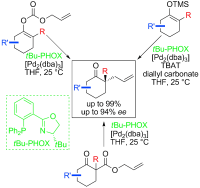Enantioselective Decarboxylative Alkylation Reactions: Catalyst Development, Substrate Scope, and Mechanistic Studies, Douglas C. Behenna, Justin T. Mohr,Nathaniel H. Sherden, Smaranda C. Marinescu, Andrew M. Harned, Kousuke Tani, Masaki Seto, Sandy Ma, Zoltán Novák, Michael R. Krout, Ryan M. McFadden, Jennifer L. Roizen, John A. Enquist Jr., David E. White, Samantha R. Levine, Krastina V. Petrova, Akihiko Iwashita, Scott C. Virgil, Brian M. Stoltz, Chem. Eur. J. 2011, 17, 14199-14223. DOI: 10.1002/chem.201003383 | [Full Text Link] [Supp. Info Link]
α-Quaternary ketones are accessed through novel enantioselective alkylations of allyl and propargyl electrophiles by unstabilized prochiral enolate nucleophiles in the presence of palladium complexes with various phosphinooxazoline (PHOX) ligands. Excellent yields and high enantiomeric excesses are obtained from three classes of enolate precursor: enol carbonates, enol silanes, and racemic β-ketoesters. Each of these substrate classes functions with nearly identical efficiency in terms of yield and enantioselectivity. Catalyst discovery and development, the optimization of reaction conditions, the exploration of reaction scope, and applications in target-directed synthesis are reported. Experimental observations suggest that these alkylation reactions occur through an unusual inner-sphere mechanism involving binding of the prochiral enolate nucleophile directly to the palladium center.

